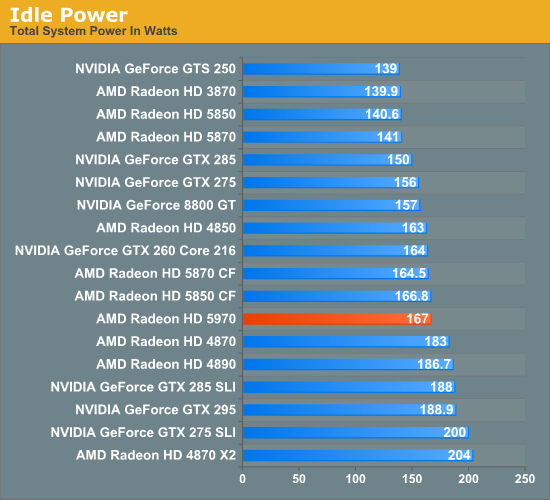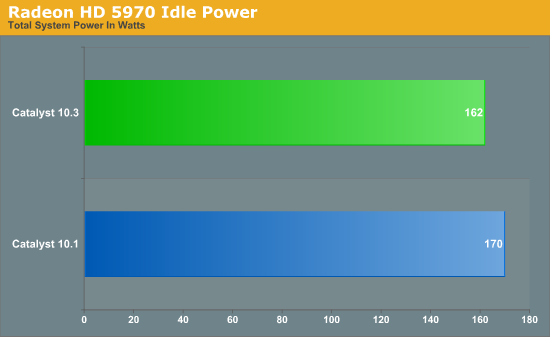What's New: AMD's Catalyst 10.2 & 10.3 Drivers
by Ryan Smith on February 16, 2010 12:00 AM EST- Posted in
- GPUs
10.2: Ultra Low Power State Confusion & Crossfire Eyefinity
When AMD was first briefing us on the 10.2 drivers, one of the first things they discussed was Ultra Low Power State (ULPS) support – this was probably a mistake. In our initial Radeon HD 5870 article covering the whole Evergreen architecture we discussed ULPS, albeit not under that name. ULPS was one of the many features AMD had briefed us about in September when they introduced the 5000 series, where ULPS allows AMD to power down the slave card(s) in a Crossfire configuration to a state even lower than idle. For the 5870/5970, this meant being able to reduce the slave(s) from 27W at idle to 20W under ULPS. This is only a 7W difference, but combined with other idle-efficient hardware it can become a notable difference. At the time it had been our understanding that this feature was enabled right out of the gate.
So imagine our confusion when at CES AMD is telling us that they are just enabling that feature for the entire 5000 series. Until that moment as far as we knew this feature was already enabled.
This started an almost immediate chain of confusion between ourselves and AMD. Terry Makedon – AMD’s Manager of Software Product Management – was giving the presentation and found himself at the end of an odd stare from us rather quickly. When we asked for clarification on this, he said that this feature was just finally going to be enabled in the mainstream Catalyst drivers, and that previously it had only been enabled for the 5970 in the launch drivers for that card. After expressing our displeasure on the issue, we quickly moved on due to time constraints.

The Radeon HD 5970: The card ULPS was practically made for
This brings us to February, where we started work on this article after wrapping up the Radeon HTPC investigation last week. Seeking further clarification on the issue and to once again express our displeasure with how this was handled, we sent an email to our favorite PR contact over at AMD, Evan Groenke. Evan has only been AMD’s PR frontman for hardware editors since the start of the year, and he’s been the guy largely responsible for helping us nail down all the issues we were seeing with the new Radeon 5000 series cards in HTPC use.
After sending that email early Friday morning, we got a phone call from Evan later that day… from the ski slopes. What was supposed to be a long weekend for him turned out to be a bit of a working weekend as he did what he could to dig in to the issue and to find a better explanation for us. Thanks to him we have a solid explanation on what’s going on and why our earlier tests were not as compromised as we once thought they were.
The key issue for AMD is that they did not consider the software side of ULPS to be ready for public use when the 5000 series launched, so it was not enabled in the Catalyst drivers at the time. ULPS was then enabled for the 5970 launch, where AMD was confident it was going to work correctly under the very limited conditions encountered by a single-card dual-GPU setup. But this was only enabled for the launch driver for the 5970 – it was never enabled in the mainline Catalyst drivers.
The issue for us, and why we were initially so displeased, was that it had never been communicated to us that ULPS wasn’t enabled from the beginning. We thought that it was enabled, AMD thought we knew that it wasn’t. So when we did our testing of the 5700, 5800, and 5900 series, we based all of our data on the idea that this feature was enabled, when in retrospect it wasn’t. Worse, it was enabled on the drivers we used to test the 5970 but not the 5870/5850, so our results would have the 5970 consuming less power at idle than what a real user would get if they used the mainline Catalyst drivers. This makes the results invalid, and was the source of our concerns.

Our original 5970 results
All of this was finally clarified when Evan was able to tell us two things: that the driver set we used to test the 5970 had been posted as a hotfix driver for the 5970 launch, and that it wasn’t the only driver with ULPS enabled. The former is of particular importance since coming from CES our interpretation had been that ULPS was not enabled on any public driver build, when in fact it just hadn’t been enabled on any mainline driver build – it had in fact been available in public hotfixes such as the 5970 launch driver. The latter is important because it was an undocumented feature of the 9.12 hotfix, which as we explained earlier is the precursor to much of what’s in the 10.2 driver being released today. So if you used the 9.12 hotfix, then you’ve already been enjoying ULPS on your 5000-series Crossfire setups.
With that in mind, here’s what the issue ultimately boils down to: Unless you were using the 5970 launch driver or the 9.12 hotfix, you have not been enjoying the benefit of ULPS. Specifically, unless you have used those drivers your idle power usage on the 5970 would have been around 7W higher than what we found in our initial 5970 review. It’s only now with today’s 10.2 driver that this is finally being enabled for customers using the mainline driver. If that’s you, then the 10.2 drivers should reduce your idle power usage some.
To settle this point, here we have a re-test of the 5970 using the 10.1 Catalyst drivers, and the 10.3 beta drivers AMD has provided us.

Our new 5970 results. Note: This is a different test setup than for our original results
The end result: a difference of 8W, out of 170W, meaning enabling it reduces idle power usage by around 5% on our overclocked Core i7 920 setup.
Moving on from ULPS, we have Crossfire Eyefinity, one of the other features that was previously exposed in the 9.12 hotfix driver. Much like ULPS, this feature was originally only enabled for the 5970 while AMD worked out the kinks in the technology. Since the 5970’s launch this feature has made a great deal of progress – it’s no longer a whitelist feature that only works on certain games, but rather it’s a blacklist feature where AMD only disables it on games where there are known issues.
We strongly suspect that anyone that had a vested interest in a Crossfire Eyefinity setup with a pair of 5800/5700 series cards already is on the 9.12 hotfix, but nevertheless this brings Crossfire Eyefinity in to the mainline drivers for everyone else.










75 Comments
View All Comments
ltcommanderdata - Wednesday, February 17, 2010 - link
Whether due to the popularity of consoles or Windows XP, in actuality, the majority of new AAA games still support DX9.0c cards like the X1000 series or the nVidia 6000 and 7000 series. Recent big name games include Aliens vs. Predator, Bioshock 2, Mass Effect 2, Dirt 2, Modern Warfare 2, Batman: Arkham Asylum, Left 4 Dead 2, Dragon Age Origins, and Wolfenstein. Upcoming major titles like Bad Company 2, Battlefield 1943, Assasin's Creed 2, Supreme Commander 2, and Napolean: Total War also support DX9.0c graphics cards.The number of major new games that support DX9.0c GPUs are probably higher than those that require DX10 generation GPUs only (for performance rather than requring DX10). Certainly, if you have a higher-end last gen DX9.0c GPU like a X1900 series there'll be new AAA games for you for the forseeable future, even if the driver support is sketchy. And games like Aliens vs. Predator and the new Battlefield games use new engines which won't have existing driver optimizations. For whatever reason, developers seem to want to continue to support DX9.0c generation GPUs, while it may be legacy driver support that give them pause, which of course may be what ATI wants.
Exodite - Wednesday, February 17, 2010 - link
I'll reiterate what I've been saying since I got my Radeon 4870 way back in 2008, the lack of automatic profiling support in AMD's drivers were the main drawback when switching over from my GeForce 7950GT.It still is.
Sure, there are third party tools that may or may not provide the same functionality but since there must be some support for automatic profiling built-in already for Catalyst AI and CrossFireX profiles to work I find it extremely annoying that I'm unable to tie my CCC profiles into specific titles.
Heck, just the ability to run automatically one OverDrive profile for 2D and one for 3D would be a major step in the right direction.
Nice article though, I'll try out the 10.2s later today then and hopefully it'll fix the issues I'm having with the ATI HDMI Sound device getting disconnected every time I resume from sleep that I've been having with the 10.1s.
JaLooNz - Wednesday, February 17, 2010 - link
Hopefully this will mean better drivers for my T400's HD3470, assuming that it works with switchable graphics. Better still if they can somehow get software switching in before nVidia releases Optimus.Mr Perfect - Wednesday, February 17, 2010 - link
Yeah, it's about time they started doing this. Nvidia made universal notebook drivers available almost a year ago, which just about makes them the default video card choice for gameing notebooks.JarredWalton - Wednesday, February 17, 2010 - link
Optimus is already available in several notebooks (ASUS UL50Vf and N61J for example), but I'd be curious to hear if the mobile drivers work with your switchable graphics T400 or not. If you can find the pre-release and test, I'd love to hear the result. :-)cactusdog - Wednesday, February 17, 2010 - link
Good work AMD. My 5870 is an awesome card but i might look at crossfire if these drivers live up to expectations.ksherman - Wednesday, February 17, 2010 - link
Is a much-needed feature! With Windows's limitation to one monitor color profile per video card, makes it tough to have color-accurate monitors in multi-screen environments. Something OS X handles beautifully. Thanks AMD!samspqr - Wednesday, February 17, 2010 - link
+1Iketh - Wednesday, February 17, 2010 - link
I'm just happy the bugs fixed in 9.12 are finally added to the 10 series... damn the oversized mouse cursor!!blyndy - Wednesday, February 17, 2010 - link
"all the issues we were seeing with the new Radeon 5000 series cards in HTPC use"all?
Is it a laundry-list of issues?
or is it a few non-show-stopper issues?
I've only heard of a minor bug or two.
ULPS and interlacing performance on low-end cards are nit-picking.